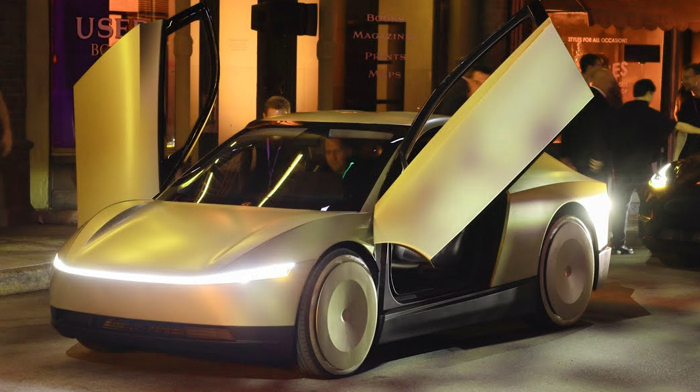Tesla has officially introduced its long-awaited autonomous taxi, dubbed the Robotaxi, during a grand reveal at Warner Bros. Studios in Burbank, California. Elon Musk, the ever-visionary CEO of Tesla, presented the vehicle as a futuristic mode of transport designed to reshape urban mobility. With a sleek design inspired by Tesla’s iconic Cybertruck, the Robotaxi promises not only cutting-edge technology but also affordability. Production is expected to start in 2026, with an entry price of under $30,000, positioning it as a game-changer in the ride-hailing industry.
Tesla’s Robotaxi: A Glimpse into the Autonomous Future
A New Era of Driverless Vehicles: The Robotaxi Unveiled
During the event, Musk referred to the Robotaxi as the “Cybercab,” a fitting moniker for the futuristic vehicle that takes design cues from the Cybertruck. The car ditches the traditional steering wheel and pedals, relying entirely on Tesla’s Full Self-Driving (FSD) software. Inside, the vehicle features a minimalist dashboard similar to that of the Tesla Model 3 and Model Y, with a central touchscreen for all essential controls.
Interestingly, the Robotaxi is a two-door hatchback with only two seats, emphasizing its design for efficiency and function. It boasts a large cargo area but skips the rear window, adding to its streamlined look. The vehicle also comes equipped with Tesla’s signature light bars at both the front and rear, along with distinctive dihedral doors and large disc-style wheel covers.
Inductive Charging and Affordable Pricing
One of the standout features is its inductive, wireless charging system—meaning no need for a traditional charging port. This innovation further highlights Tesla’s commitment to simplifying the charging process, potentially boosting the convenience of operating an autonomous fleet. While Musk kept powertrain details under wraps, he confirmed that the Robotaxi would hit the market with a sub-$30,000 price tag.
Production timelines, however, remain flexible, with Musk humorously stating that while he expects the Robotaxi to be available by 2026, it will definitely roll out “before 2027.” This follows Musk’s history of optimistic projections, but even with delays, the Robotaxi’s arrival marks a significant milestone in the electric vehicle (EV) industry.
A New Kind of Ride-Hailing Fleet
Although Musk didn’t explicitly discuss Tesla’s “Network”—a potential platform where Tesla owners could enlist their autonomous vehicles for ride-sharing—he painted a picture of a future where fleet ownership becomes accessible to the masses. He suggested that individuals could operate fleets of Robotaxis much like Uber drivers do today, without ever needing to drive the vehicles themselves.
Event attendees were also offered a rare opportunity to ride in the Robotaxi. Although the test drives were limited to short loops around a film set, the excitement around experiencing the first fully autonomous Tesla was palpable.
Overcoming Regulatory Hurdles
Despite all the buzz, Tesla still faces regulatory challenges before the Robotaxi can operate autonomously on public roads. Musk optimistically suggested that Tesla’s Full Self-Driving system might be able to run unsupervised as early as next year, but that remains contingent on regulatory approval in key markets such as California and Texas.
Tesla’s Optimus Robot and the Robovan: Expanding the Autonomous Vision
In addition to the Robotaxi, Tesla revealed more details about Optimus, its humanoid robot designed for a wide range of tasks. Musk emphasized the potential of these robots to revolutionize both personal and professional life, envisioning them as household helpers or companions. Optimus robots, expected to retail between $28,000 and $30,000 in the long term, even entertained the audience with a playful dance, showcasing their dexterity.
Another surprise at the event was the unveiling of the Robovan—a fully autonomous van that Tesla plans to produce. With the capacity to carry up to 20 passengers, the Robovan can also serve as a commercial transporter, ideal for goods delivery or passenger services. Its futuristic design, featuring expansive glass windows and sliding side doors, attracted considerable attention, although no pricing or release date details were provided.
Conclusion: Tesla’s Vision of an Autonomous Future
The unveiling of Tesla’s Robotaxi marks a pivotal moment in the autonomous vehicle revolution. With its innovative design, affordability, and advanced technology, the Robotaxi is poised to disrupt the transportation industry. However, Tesla’s journey to a fully autonomous future will depend on overcoming regulatory challenges and perfecting its self-driving software.
Alongside the Robotaxi, the introduction of the Optimus humanoid robot and the Robovan signals Tesla’s broader ambition to shape the future of robotics and autonomous mobility. While the timeline for these products remains flexible, their potential impact on both everyday life and industry is undeniable. As we move closer to 2026, all eyes will be on Tesla as it continues to push the boundaries of what’s possible in autonomous transport and robotics.
